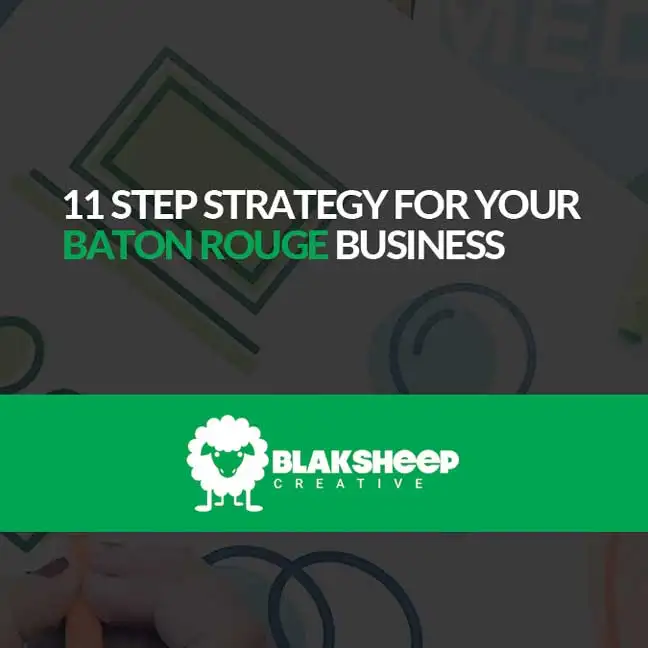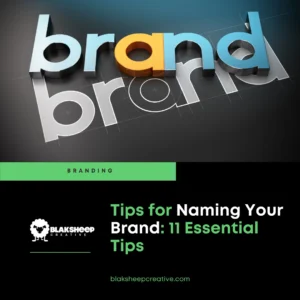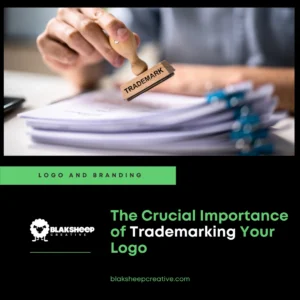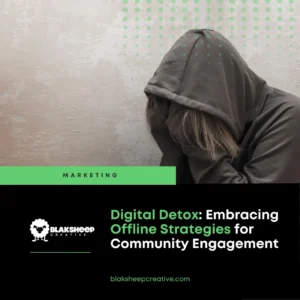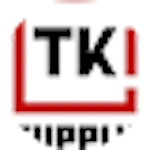Your small business branding strategy is so much more than just a flashy logo and some social media posts.
Sadly, we’ve seen several Baton Rouge marketing agencies design a great logo design or a fancy website for a client and stop at that, overlooking some of the main steps to creating a brand strategy that resonates with customers.
We realize that, as a small business or startup, chances are you’re operating on limited resources and a shoestring budget. Also, you probably don’t have the money to drop on hiring some fancy branding expert to help you build your brand.
Don’t worry!
This article will show you ten simple (and free) steps you can take to create effective branding for your small business or organization.
What is a brand?
First, let’s begin by defining a brand.
According to the American Marketing Association, branding is defined as “A brand is a name, term, design, symbol or any other feature that identifies one seller’s good or service as distinct from those of other sellers.” [American Marketing Association, Definitions of Marketing]
Your brand is what sets you apart from your competitors and allows you to control how your business is perceived.
Be warned, branding is not a one-size-fits-all kind of deal.
Building an effective brand identity is a process. So, where do you start?
10 steps that you can take right now to craft a foolproof branding strategy.
Follow the following ten steps to create a foolproof branding strategy:
1. Define your brand identity.
As we said earlier, branding is more than just a logo you slap on your website.
Your branding illustrates, among other things:
Who you are as a business
Your company’s values and mission your attitude toward your customers
Prior to moving with other steps in your branding and marketing strategy (such as logo design), you need to stop and get crystal clear on who you are as a company.
This is known as your brand identity.
2. Define who you really are.
In this step, you’ll want to do some introspection and figure out exactly who you are and who you want to be from a brand standpoint. In this step, ask yourself questions such as:
- If I only had three words to describe my company, what would they be?
- What are my company’s core values and missions?
- What does our small business want to be known for in our niche?
The more details you know about who you are and what you’re about, the better you will be prepared to use these details in your branding so that it will stand out and grab customers’ attention.
3. Define your target customers.
Sure, you may have the best products or services in your area, but if you don’t define your target audience, your marketing efforts won’t be as successful as possible.
Take a moment and define your ideal customer by asking questions such as:
- Who are they?
- How old are they?
- What’s their income?
- What’s their education?
- What’s their gender?
- What are they looking for?
- What’s important to them?
- Why would they benefit from using your service?
After answering these questions, you can use it to help guide your overall branding strategy, resulting in a brand that connects with the customers you want to reach (and convert) the most.
4. Define your point of difference (POD)
Even if you’re selling the most unique product or service, chances are there’s someone doing the exact same thing.
Competition is inevitable!
That’s why it’s important to know what it is that makes you different from your competitors. This is called your point of difference (or POD).
Your POD is what makes your company special and what drives customers to choose you over your competition.
Your POD should be a critical part of your branding and should be infused into every part of your brand messages and strategy.
Don’t worry, your POD doesn’t have to be anything complicated, just simply what makes your company uniquely you, such as:
- Price
- Variety
- Features
- Benefits
- Availability
- Convenience
- Customer service
- Your story (how, why, or where you do business)
How to figure out your point of difference
Here are some methods that you can use to figure out your point of difference.
Method One: Be a Branding Detective
- Get a piece of lined paper and create three columns.
- In the first column, list one of your top competitors.
- In the second column, write down how your products are similar (both use quality ingredients; both cost $10; both are health foods, etc).
- In the third column, write down how your products are different (theirs are made in China/mine are made locally; theirs costs $100/mine costs $19; theirs comes in two flavors/mine comes in 10, etc.).
- Repeat steps 1-4 for up to 10 competitors. When you’re done, highlight any recurring points you’ve listed in the “differences” column.
Those highlighted phrases are recurring points that show some major differentiation that you can use to easily stand apart from the competition.
Method Two: When in doubt, ask.
Find someone unrelated to you that you can ask what makes your product stand out.
Obviously, your parents, friends, or spouse will be biased, so it’s important to make sure they’re impartial.
- Ask your customers.
- Ask them why they purchased from you in the past.
- Ask them if they considered buying from the competition.
- Ask them what made them choose your product instead.
- Ask them what they like about your product.
- Ask them what they don’t like about your product.
- Ask them why they feel that your product is the best choice for them.
Ask these questions to as many customers as you can — preferably 20 or more.
Write the answers down, and look through the list to spot recurring points of difference.
To make this process even easier, you could use a product like Survey Monkey to send a quick survey to your last 50 customers so that your answers will be organized and ready for point of difference analysis.
No matter what method you use, remember to build your POD directly into your brand’s identity.
5. Select a brand name that is easy to say, spell, hear, and remember.
According to Forbes Magazine, you only have 7 seconds to make a first impression.
And, just like your brand’s visual assets (we’ll get to that in a second), your business name plays an important role in what people will think.
Now, don’t overthink while naming your brand. Just remember that your brand name should be something that can easily be pronounced, spelled, remembered, and repeated.
Keep your brand name easy on both the lips and the fingertips!
For more detailed tips on naming your brand, check out our comprehensive guide on 11 Tips for Naming Your Brand.
6. Create your brand’s visual assets.
Now that you know who your customers are and what differentiates you from your competitors, it’s time to start designing your brand.
Whether you’re a big brand or a small brand, this is a critical step
Here are some of the things that you’ll need to create the look and feel of your brand:
A brand style guide. Before you begin to design, you must figure out all of the details of your design strategy. Decide on things such as typography (fonts), color palettes, and the overall “vibe” that your brand will consist of. Your brand style guide is an important way to organize the details of your design and ensure that you, your designer, or anyone working on your brand, promotional materials, or marketing materials are on the same page with your brand’s direction. A brand without guidelines looks scattered and lacks uniformity.
A Logo. Your logo is the face of your company. It’s the first introduction your customers will likely get of your brand. It’s the visual asset that will be closely tied to your business. You should make a logo design one of your first steps in the design process because it will serve as the basis and starting point for all of your other visuals, such as your website, business cards, and promotional materials.
A Website. As a new small business in 2020, your business must have an online presence. Your website is one of the important pieces of digital real estate and should be created as soon as possible to announce your arrival and get the SEO process rolling. Just make sure that the look and feel of your website design are consistent with the rest of your branding (and the brand style guide you created above).
Business Cards. Although we live in the digital age, physical business cards are still relevant. Make sure that your business card’s design matches your logo and other design assets by referring to your brand style guide (see why we said it’s important?)
Other Branding Assets. Depending on your niche and industry, you may need additional branding assets such as product packaging, letterhead, or promotional materials.
It’s important to remember that no matter where a customer encounters your brand (e.g., seeing your logo in an ad, visiting your website, visiting your store), the look, feel, and design should be consistent.
For more insights on creating a strong and protected logo, check out our article The Crucial Importance of Trademarking Your Logo.
7. Position yourself as a brand matter expert.

As a new startup or small business, you may not have a big advertising budget.
Fortunately, you don’t need to spend hundreds of dollars to get your brand in front of a lot of people. You can do it more effectively, cheaper, and easier by using content marketing.
Here’s why content marketing is so effective:
- It allows you to show off your expertise by establishing yourself as a subject matter expert and a go-to resource in your field or industry.
- It will build trust in your audience, and when they decide on a company to do business with, this trust will give you a leg up over your competition.
Content marketing is also a great branding strategy because it allows you to build strong brand positioning. By creating a strong brand voice and then carrying that voice throughout all of your generated content, you really drive home what you’re really about to your customers.
This helps strengthen your relationship with potential customers, which helps drive business.

Here’s why content marketing is affordable:
You can do it yourself!
The recipe for success in using content as a marketing strategy is to create the right content.
Do your due diligence and research what kinds of questions your customers are asking, and then simply create content that answers them.
For Example:
You own a local automotive shop off of College Drive, and after researching, you realize that customers are searching for ways that they can save money by changing their own oil at home.
You could create a branded blog post or YouTube video that outlines the basics of changing a vehicle’s oil, the importance of changing your oil, the benefits of doing so, what items you’ll need, etc.
This kind of content provides value to your audience and shows your knowledge of your trade.
Now, when someone doesn’t have the time or want to change their oil at home, you’ll be the first place that they visit.
8. Find partnership opportunities.

People prefer to do business with trusted brands. However, if you’re a new brand, it may take time and effort to build that trust.
The good news is that you can speed up that process by partnering with other brands that your customers may already do business with.
Basically, it’s trust-building via proxy.
But how do you find partnership opportunities?
- Find businesses with similar (but non-competitive) audiences. For example, let’s go back to our automotive shop analogy:
- Partner up with local racing teams and offer samples of your products in gift bags that they pass out at local races.
- Offer to write guest posts on popular auto racing blogs.
You see, all of these companies want to target the same audience as you – auto owners, but none of them are your competition, which will make them more willing to partner with you.
9. Make customer service your first priority.

If you really want to stand out in the hyper-competitive market in 2020, you have to do more than talk the talk; you need to walk the walk, too.
Remember, your brand is about so much more than your logo, your marketing strategies, or how you get (and hopefully keep) your customers’ attention.
Your brand is also about what you do once connected to these customers, your reputation, and what is said behind your back.
Some believe that this is the most important part of your branding.
So, if you want to have long-term success, you need to make customer service your number one priority.
Live, breathe, and sleep it.
What’s one of the best ways to advertise and promote your company
Word of Mouth
If your customers have a positive experience when they interact with your brand, they’ll keep coming back and tell their friends, too!
Remember, customer service is bigger than one single interaction or department.
Positive reviews are critical for business and for SEO.
If you really want to live, breathe, and sleep customer service, you have to consistently provide a positive experience for your customers, no matter how they behave toward your brand.
Be sure to look for opportunities to improve your business’s customer service.
- Is your website confusing? Redesign it to make it more user-friendly.
- Is returning a product difficult? Revisit your return policy and perhaps provide prepaid shipping labels with clear instructions to make the process easier.
Basically, the more that you can improve customer experience, the more you’ll be known (and discussed) as a company that genuinely cares about its’ customers, and the more customers you’ll gain as a result.
10. Boost your branding strategy.
Now that you’ve got the foundation for your small business branding strategy in place, it’s time to give it a boost.
The good news is that you don’t need to spend an arm and a leg to effectively brand your business.
All you need is a little creativity and hard work.
Some free ideas you can use to create a buzz about your company:
- Giveaways on social media.
- Being active in the local community (Mid-City is notorious for its’ activism)
- Providing pro-bono work to a local charity such as The Boys’ Club in NBR.
Small business strategy recap:
Now that you’ve got a detailed list of how to create a solid small business branding strategy, it’s time to put it in motion.
We realize that it may seem like a lot, so just take it into bite-sized chunks and, just have fun while staying true to your brand.
Of course, if you have any questions or need help implementing this small business branding strategy for your Baton Rouge business, we are here to help. Just contact us, and we’ll give you a free consultation.
